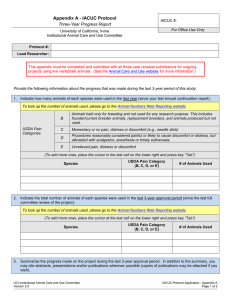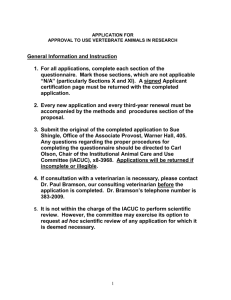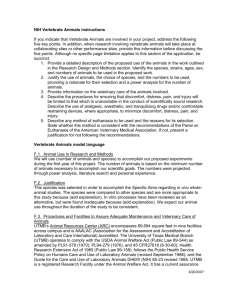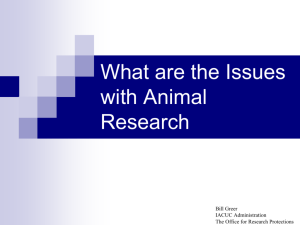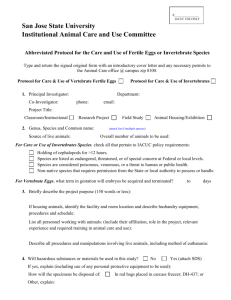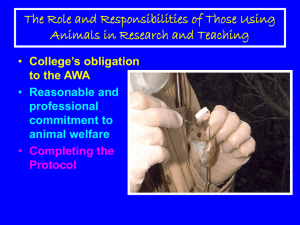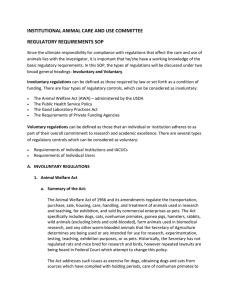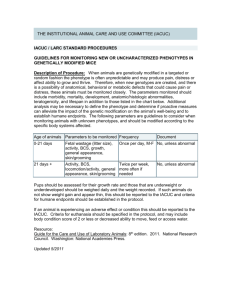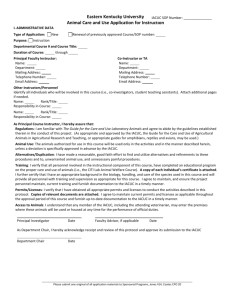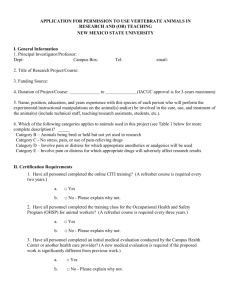Use of Animals in Course
advertisement
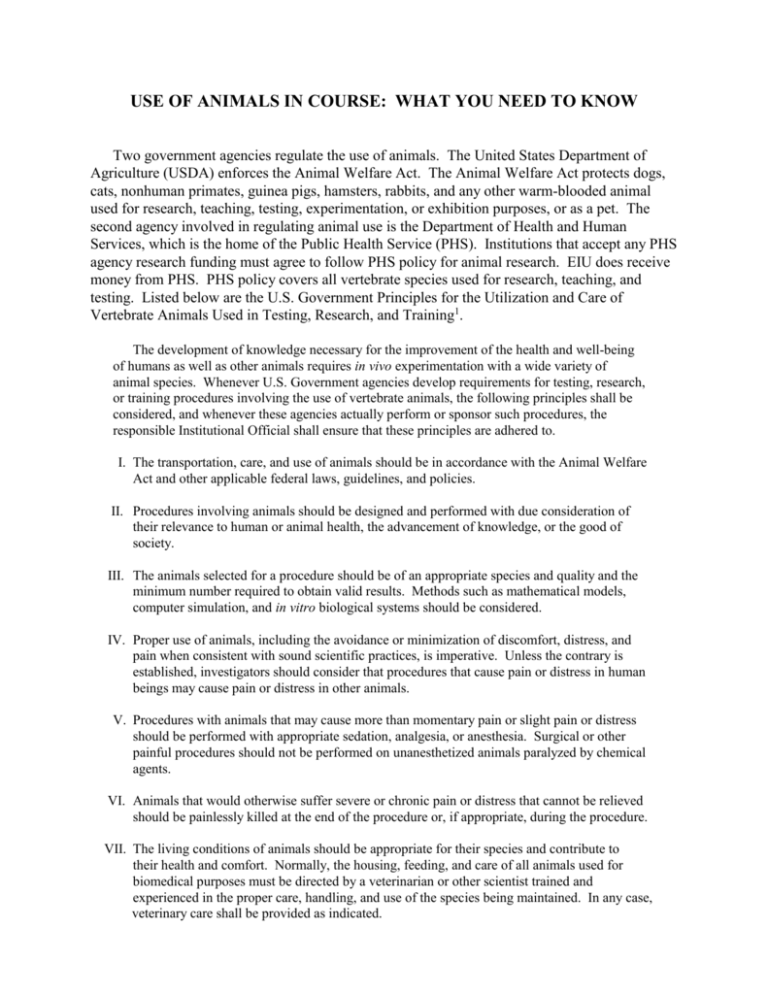
USE OF ANIMALS IN COURSE: WHAT YOU NEED TO KNOW Two government agencies regulate the use of animals. The United States Department of Agriculture (USDA) enforces the Animal Welfare Act. The Animal Welfare Act protects dogs, cats, nonhuman primates, guinea pigs, hamsters, rabbits, and any other warm-blooded animal used for research, teaching, testing, experimentation, or exhibition purposes, or as a pet. The second agency involved in regulating animal use is the Department of Health and Human Services, which is the home of the Public Health Service (PHS). Institutions that accept any PHS agency research funding must agree to follow PHS policy for animal research. EIU does receive money from PHS. PHS policy covers all vertebrate species used for research, teaching, and testing. Listed below are the U.S. Government Principles for the Utilization and Care of Vertebrate Animals Used in Testing, Research, and Training1. The development of knowledge necessary for the improvement of the health and well-being of humans as well as other animals requires in vivo experimentation with a wide variety of animal species. Whenever U.S. Government agencies develop requirements for testing, research, or training procedures involving the use of vertebrate animals, the following principles shall be considered, and whenever these agencies actually perform or sponsor such procedures, the responsible Institutional Official shall ensure that these principles are adhered to. I. The transportation, care, and use of animals should be in accordance with the Animal Welfare Act and other applicable federal laws, guidelines, and policies. II. Procedures involving animals should be designed and performed with due consideration of their relevance to human or animal health, the advancement of knowledge, or the good of society. III. The animals selected for a procedure should be of an appropriate species and quality and the minimum number required to obtain valid results. Methods such as mathematical models, computer simulation, and in vitro biological systems should be considered. IV. Proper use of animals, including the avoidance or minimization of discomfort, distress, and pain when consistent with sound scientific practices, is imperative. Unless the contrary is established, investigators should consider that procedures that cause pain or distress in human beings may cause pain or distress in other animals. V. Procedures with animals that may cause more than momentary pain or slight pain or distress should be performed with appropriate sedation, analgesia, or anesthesia. Surgical or other painful procedures should not be performed on unanesthetized animals paralyzed by chemical agents. VI. Animals that would otherwise suffer severe or chronic pain or distress that cannot be relieved should be painlessly killed at the end of the procedure or, if appropriate, during the procedure. VII. The living conditions of animals should be appropriate for their species and contribute to their health and comfort. Normally, the housing, feeding, and care of all animals used for biomedical purposes must be directed by a veterinarian or other scientist trained and experienced in the proper care, handling, and use of the species being maintained. In any case, veterinary care shall be provided as indicated. VIII. Investigators and other personnel shall be appropriately qualified and experienced for conducting procedures on living animals. Adequate arrangements shall be made for their in-service training, including the proper and humane care and use of laboratory animals. IX. Where exceptions are required in relation to the provisions of these Principles, the decisions should not rest with the investigators directly concerned but should be made, with due regard to Principle II, by an appropriate review group such as an institutional animal care and use committee. Such exceptions should not be made solely for the purposes of teaching or demonstration. By law, Eastern Illinois University has a committee that must review all aspects of the animal care and use program. This committee is the Institutional Animal Care and Use Committee or IACUC. The IACUC is responsible for making sure that all federal laws, regulations and policies are followed when investigators perform animal research. The IACUC has many responsibilities, including: (1) Reviewing and approving animal use in experiments and (2) monitoring the animal care and use program by conducting semiannual reviews of the program and inspections of the animal facilities. Eastern’s IACUC reviewed and approved the use of animals in this course you are taking and the facilities in which the animals are housed. Animals are used in courses only after considering questions such as: (1) “Will using animals teach students concepts that will eventually improve the health of people or animals?" (2) "What is the experimental design of the animal studies planned?" (3) “Is the species of animal appropriate for the teaching goals?” (4) “Are there good alternatives to using animals?” Alternatives include replacing animals with non-animal techniques, reducing the number of animals used, and refining procedures so as to cause minimum discomfort to animals. It is imperative that students carefully follow the procedures given by their instructor and those found in the laboratory manual since the IACUC reviewed those procedures to assure minimum discomfort for the animals. It is also important that students listen to and carefully follow instructions for handling animals. 1. Public Health Service Policy on Humane Care and Use of Laboratory Animals. National Institutes of Health, Office for Protection from Research Risks, March 1996.
